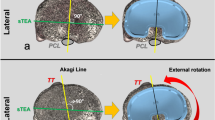Abstract
In patients with either lateral tracking patella or unstable patella the pathological lateral position of the tuberosity can be corrected by a medial transfer. This study compared the results of subtle CT-guided correction of the tuberosity for objective unstable patella (n=27) with the results for lateral tracking patella (potential instability) as described by Dejour (n=16). Follow-up was 37 months. CT revealed a pathological lateralization of the tibial tuberosity–trochlear groove greater than 15 mm in 41 knees. These patients underwent medialization of the tibial tuberosity up to 10–12 mm lateral from the trochlear groove, and 28 patients underwent a distalization to normalize the Caton index to 1.0–1.2. Results were evaluated using Cox' method. Patients with objective patellar instability were rated as 11% excellent, 52% good, 33% fair, and 4% poor. All patients became stable except one who had a 6° valgus alignment. Although 96% had improved stability, 33% of the patients still had pain. The patients with lateral tracking patella (potential instability) were rated as 37.5% excellent, 44% good, and 19% fair. The lower proportion of pain relief in patients with unstable patella is likely the result of the cartilage damage experienced by these patients following multiple dislocations. Thus the patient with lateral tracking patella without patella dislocations must be differentiated from the one with unstable patella. Their prognosis in pain relief is better.




Similar content being viewed by others
References
Ahmad C, Shubin Stein B, Matuz D, Henry J (2000) Immediate surgical repair of the medial patellar stabilizers for acute patellar dislocation. Am Orthop Soc Sports Med 28:804–810
Arnbjörnsson A, Egund N, Rydling O, Stockerup R, Ryd L (1992) The natural history of recurrent dislocation of the patella. Long-term results of conservative and operative treatment. J Bone Joint Surg Br 74:140–142
Boden B, Pearsall A, Garret W, Feagin J (1997) Patellofemoral instability: evaluation and management. J Am Acad Orthop Surg 5:47–55
Cox J (1982) Evaluation of the Roux-Emslie-Trillat procedure for the knee extensor realignment. Am J Sports Med 10:303–310
Dejour H, Walch G, Nove-Josserand L, Guier C (1994) Factors of patellar instability: an anatomic radiographic study. Knee Surg Sports Traumatol Arthrosc 2:19–26
Dejour H, Walch G, Neyret P, Adeleine P (1990) La dysplasie de la trochlee femorale. Rev Chir Orthop Reparatrice Appar Mot 76:45–54
Delgado-Martins H (1979) A study of the position of the patella using computerised tonography. J Bone Joint Surg Br 61:443–444
Ficat P, Ficat C, Bailleux A (1975) Syndrome d'hyperpression externe de la rotule (SHPE). Son intérêt pour la connaissance de l"arthrose. Rev Chir Orthop Reparatrice Appar Mot 61:39–59
Fulkerson J, Becker G, Meaney J (1990) Anteromedial tibial tubercle transfer without bonegraft. Am J Sports Med 18:490–496
Grelsamer R (2000) Current concepts review: patellar malalignment. J Bone Joint Surg Am 82:1639–1647
Guzzanti V, Gigante A, Di Lazzaro A, Fabbriciani C (1994) Patellofemoral malalignment in adolescents. Computerised tomographic assessment with or without quadriceps contraction. Am J Sports Med 22:55–60
Hampson W. Hill P (1975) Late results of transfer of the tibial tubercle for recurrent dislocation of the patella. J Bone Joint Surg Br 57:209–213
Hauser E (1938) Total tendon transplant for slipping patella. A new operation for recurrent dislocation of the patella. Surg Gynecol Obstet 66:199–213
Insall J, Windsor R, Scott W, Kelly M, Aglietti P (1993) Surgery of the knee, 2nd edn. Churchill Livingstone, New York
Maënpää H, Lehto M (1997) Patellfemoral osteoarthritis after patellar dislocation. Clin Orthop 339:156–162
Masse Y (1978) "La trochléoplastie." Restauration de la gouttière trochléene dans les subluxations et luxations de la rotule. Rev Chir Orthop Reparatrice Appar Mot 64:3–17
McConnel J (1985) The management of chondromalacie patellae: a long term solution. Aust J Physiother 32:215–222
Myers P, Williams A, Dodds R, Bülow J (1999) The three-in-one proximal and distal soft tissue patellar realignment procedure. Am Orthop Soc Sports Med 27:575–579
Rillman P, Oswald A, Holzach P, Ryf C (2000) Fulkerson's modified Emslie-Trillat procedure for objective patellar instability and patellofemoral pain syndrome. Swiss Surg 6:328–334
Scuderi G (1992) Surgical treatment for patellar instability. Orthop Clin North Am 23:619–629
Twano T, Kurosawa H, Tokuyama H, Hoshikawa Y (1990) Roentgenographic and clinical findings of patellofemoral osteoarthrosis. With special reference to its relationship to femorotibial osteoarthrosis and etiologic factors. Clin Orthop 252:190–197
Author information
Authors and Affiliations
Corresponding author
Rights and permissions
About this article
Cite this article
Diks, M.J.F., Wymenga, A.B. & Anderson, P.G. Patients with lateral tracking patella have better pain relief following CT-guided tuberosity transfer than patients with unstable patella. Knee Surg Sports Traumatol Arthrosc 11, 384–388 (2003). https://doi.org/10.1007/s00167-003-0415-2
Received:
Accepted:
Published:
Issue Date:
DOI: https://doi.org/10.1007/s00167-003-0415-2




